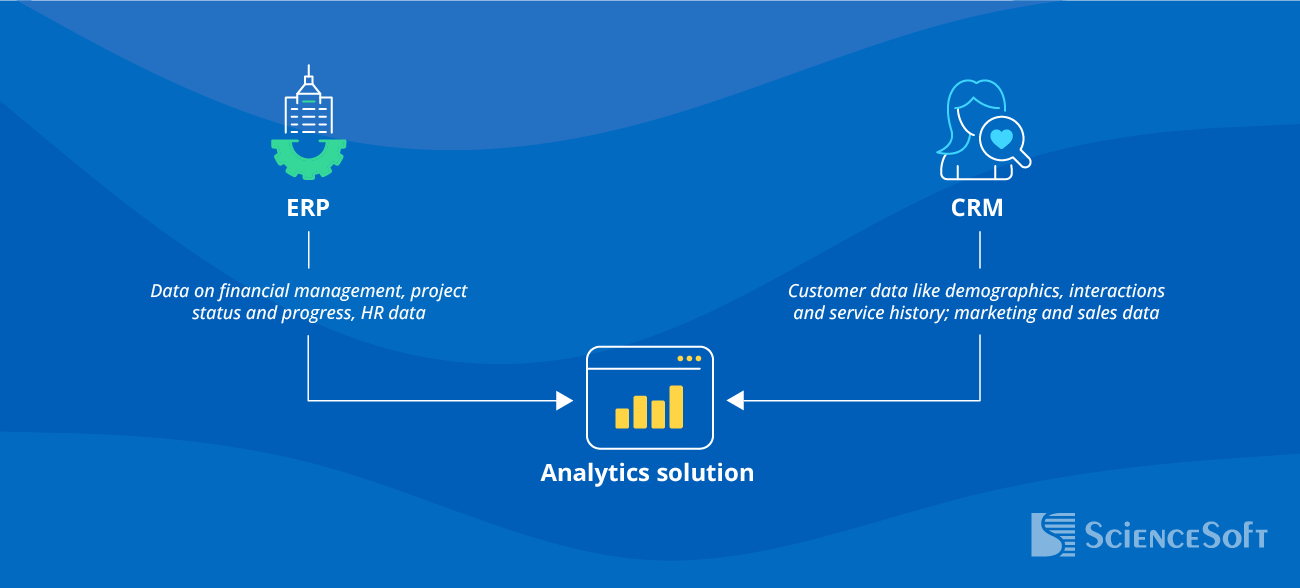Data Analytics for Professional Services
Use Cases, Implementation Best Practices, Costs
Since 2008 in IT solutions for professional services, ScienceSoft builds custom analytics software that allows companies gain real-time visibility into project management, personalize their offering, promptly adjust business decisions in line with market changes, and more.
Data analytics for professional services is a way to consolidate disparate data on project, customer, marketing, and talent management and drive insights on project delivery improvement, effort and resource allocation, customer attraction and retention, costs optimization, and more.
- Development time: 2—6 months for an MVP.
- Costs: $30,000—$800,000 depending on the solution's complexity. Use our online calculator to get a ballpark estimate for your case.
- Core integrations: ERP, CRM.
- ROI: up to 220%
Key Analytics Features for Professional Services Companies
Core Integrations for Analytics Solutions in Professional Services

ERP
- To enable data-driven project delivery improvement.
- To analyze financial management processes, get financial forecasts, and mitigate risks.
- To support accurate financial reporting.
- To optimize employees' productivity and increase talent retention.
- To efficiently manage customer demand and resource supply.
CRM
NB: Depending on your needs, we can integrate your solution with a customer portal.
- To personalize customer service and ensure accurate service quoting.
- To understand customer sentiment toward the provided services.
- To increase marketing campaign performance.
4 "Hows" to Consider When Developing Analytics Software for Professional Services
Development of analytics software for professional services is aimed at delivering a solution that drives business value through tailored capabilities, a cost-optimized architecture, case-specific UX/UI design, and other factors. Below, you can explore major points of attention for developing a successful analytics solution for a professional services company.
1.
How to meet business goals
During the stage of business analysis, it is essential to conduct interviews with business executives, domain specialists, finance teams, and other stakeholders to elicit their needs and expectations, translate them into requirements for the solution, and prioritize them throughout the development process.
ScienceSoft often uses Agile approach in analytics solutions development. This helps us adjust the software according to early user feedback and avoid costly and time-consuming redevelopment (compared to introducing changes to the final software version).
2.
How to optimize development costs
There are many ways to optimize development costs without sacrificing the solution's functionality or quality. E.g., ML/AI-powered capabilities do not always require building custom ML models. For cases like sentiment analysis and customer service chatbots, open-source models can be used with little to zero customization.
ScienceSoft's cost optimization practices include the reuse of proven third-party components and microservices, QA automation, and implementation of CI/CD pipelines. All this allows us to achieve up to a 78% decrease in costs.
3.
How to optimize the TCO
A tailored approach to solution architecture design can help achieve the optimal cost-to-performance ratio of the analytics software. E.g., it can be feasible to use cashing mechanisms for storing frequently accessed data (e.g., on real-time project management) or enable workload-dependent scaling of resources to optimize cloud costs.
Software TCO also largely depends on the pricing of technology vendors. Being technology agnostic, ScienceSoft can choose among multiple providers and go for the ones that offer an optimal combination of performance, scalability, and pricing in each particular case.
4.
How to ensure smooth user adoption
It's essential to give users instruments that facilitate the execution of their role-specific tasks. E.g., capabilities for granular representation of financial data can help financial teams identify cost-saving opportunities and revenue trends, while static dashboards that provide a 360-degree view of operations can give C-levels a quick and clear understanding of the company's health and progress.
One of our UX/UI design practices includes auditing the software that the company has in use and implementing similar workflows in the new analytics solution.
Costs & ROI of Developing Analytics Software for Professional Services
Costs of professional services analytics software development can vary from $30,000 to $800,000+. The exact figure largely depends on the organization's size (e.g., companies with several service lines and geographical locations will require more data sources for integration) and the complexity of the analytics features (e.g., rule-based or ML/AI-powered analytics, big data analytics).
Analytics in professional services can bring an average ROI of 220% that is driven by capabilities for service personalization, high-value customer attraction, marketing campaign improvement, and informed resource planning.
|
|
A basic solution |
A solution of medium complexity |
An advanced solution |
|---|---|---|---|
|
Average organization size
?
The more employees, service lines, and geographical locations a company has, the more complex the solution will be in terms of the required features and the number of data sources to be integrated. |
<200 employees |
200-1000 employees |
>1000 employees |
|
Data complexity
|
Structured (e.g., relational databases, XML, Parquet files). |
Structured and semi-structured (e.g., JSON, ORC files). |
Structured, semi-structured, and unstructured (e.g., DOCX, JPG, MP3, MP4, HTML files). |
|
Data processing frequency
|
Batch (e.g., every 24 hours) |
Batch and real-time |
Batch and real-time |
|
Analytics scope
|
Basic reporting: core financial KPIs, resource utilization, billable hours, performance by employee/unit. |
Specialized analytics for different departments, service lines, and customer segments. In-depth financial analytics (e.g., insights into cost allocation, planned vs. actual KPIs). |
A 360-degree view of operations and assets across locally and internationally distributed enterprise systems (e.g., PMS, CRM). M&A analytics. |
|
AI and machine learning
|
|
Simple, ready-made AI models (e.g., for customer sentiment analysis). |
Custom or fine-tuned AI models (e.g., multi-factor what-if models, forecasting based on historical and real-time data). |
|
Reporting and visualization
|
Via market-available tools like Power BI, Tableau, Looker. |
Via market-available tools like Power BI, Tableau, Looker. |
Via market-available tools like Power BI, Tableau, Looker, and custom data visualization modules. |
|
Cost
|
$30,000—$150,000 |
$150,000—$300,000 |
$300,000—$800,000+ |
Get a Cost Estimate for Professional Services Analytics Development
Please answer a few questions about your business needs, and our experts will get back to you with a custom cost estimate.
Thank you for your request!
We will analyze your case and get back to you within a business day to share a ballpark estimate.
In the meantime, would you like to learn more about ScienceSoft?
- Project success no matter what: learn how we make good on our mission.
- 35 years in data management and analytics: check what we do.
- 4,000 successful projects: explore our portfolio.
- 1,300+ incredible clients: read what they say.



